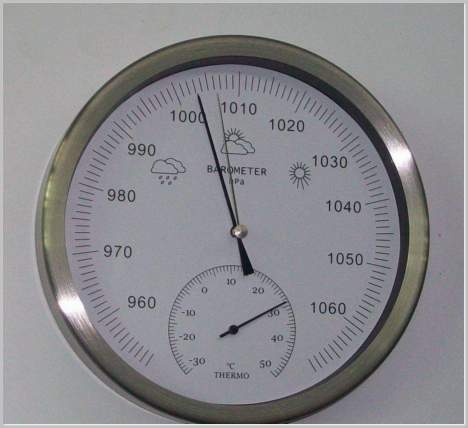
A barometer measures air pressure. Because the movement of weather systems is strongly dependent on areas of high and low pressure, a barometer is very useful in weather prediction.
Evanglista Torricelli invented the barometer in 1643. He was investigating the use of pumps in flooded mines, and wondered why it wasn’t possible to lift water all the way to the surface with one pump. He had the insight that we live at the bottom of the atmosphere, and that all this air has weight and exerts pressure. It holds down the water in a mine. Torricelli set out to measure the air’s pressure, and succeeded in inventing the barometer.
The simplest kind of barometer, which is still in use today, measures the pressure of air above it by measuring how high the air’s pressure pushes a column of mercury in a glass tube.
The air is removed from a tube, and then it is inserted upside down into a basin of mercury. Mercury is used because it is heavy, visible, and liquid. The air pressure on the surface of the bowl of mercury pushes it downward. The pool of mercury then has less room in the basin, and pushes farther up the glass tube. The harder the air pushes down on the liquid in the bowl, the farther it will be pushed up the tube. When the air pressure falls, the liquid in the bowl will be able to rise. Therefore, there will be less pressure on the mercury in the tube, and it will fall.
Markings on the tube indicate the air pressure. The U.S. Weather Service indicates pressure at ground level in inches of mercury. Outside of the U.S., Liberia, and Burma, most countries use metric measurements.
Mercury barometers are not used as much as they once were. Mercury is a persistent poison. Its use in barometers, as well as thermometers, is actually illegal in Europe. A barometer can measure air pressure using water as well.
A more compact kind of barometer hangs on many people’s walls. An aneroid barometer is the commonest kind in use today. It measures air pressure without using mercury or any other liquid. Instead, it employs a hollow capsule. This capsule expands and contracts with changes in air pressure, and sensitive instruments measure its change.
The capsule is usually made of an alloy of beryllium and copper. The mechanisms that transmit the information to the dial are sensitive and intricate. The faces of most barometers have a dial that shows the barometer’s last reading. The pointer giving the current reading is often designed to be slightly “sticky”, so that it changes when it is tapped. This enables anyone using the barometer to see recent changes in air pressure, as well as the current pressure itself.
That is because it is a change in pressure that predicts a change in weather. In general, high pressure indicates fair weather, because high local pressure pushes away incoming storm systems. Low pressure allows storms to enter an area. Therefore, when the pressure changes to low, a storm may be on the way. When sailors in old movies say, “The glass is falling,” they mean, “Watch out for storms.”
Once Torricelli had his great insight, it was not difficult for him to construct a barometer. Here are instructions for making two different barometers, from the U.S. Weather Service. No mercury is involved, and the simple barometers work.
A barometer indicates air pressure, by calibrating its effect on a column of liquid or a bit of flexible metal. By indicating changes in air pressure, a barometer can provide valuable information about the weather.

